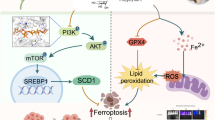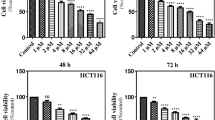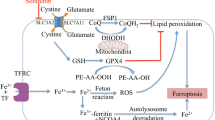Abstract
Exposure to arsenic (As) is a risk factor for the development of diabetes, vascular diseases and cancer. Several theories have been proposed to account for the mechanisms potentially responsible for As toxicity and carcinogenesis. Currently, we have investigated whether the eukaryotic translation initiation factor 4E (eIF4E), the mRNA cap binding and rate limiting factor required for translation, is a target for As-induced cytotoxicity and cell death. We have also investigated the potential cellular mechanisms underlying the As-induced de-regulation of expression of eIF4E that are most likely responsible for the cytotoxicity and cell death induced by As. Exposure of four different human cell lines – HCT15 (colorectal adenocarcinoma), PLC/PR/5 (hepatocellular carcinoma), HeLa (cervical adenocarcinoma) and Chang (likely derived from HeLa cells) to sodium arsenite (NaAsO2) for time intervals up to 24 h resulted in a concentration-dependent cytotoxicity and cell death. All the NaAsO2-treated cells exhibited significant inhibition of eIF4E gene (protein). The potential involvement of eIF4E gene expression in the NaAsO2-induced cytotoxicity and cell death was investigated by silencing the cellular expression of the eIF4E gene by employing a small interfering RNA (SiRNA) specifically targeting the eIF4E gene's expression. The SiRNA-mediated silencing of eIF4E gene expression also resulted in significant cytotoxicity and cell death suggesting that the toxicity noticed among the NaAsO2-treated cells was probably due to the chemically induced inhibition of eIF4E gene expression. The potential involvement of inhibition of eIF4E gene expression in the NaAsO2-induced cytotoxicity and cell death was further investigated by employing transgenic cell lines overexpressing the eIF4E gene. Overexpression of the eIF4E gene in the Chinese hamster ovary cell line was protective against the NaAsO2-induced cytotoxicity and cell death. Additional studies conducted to understand the potential mechanisms responsible for NaAsO2-induced inhibition of eIF4E gene expression demonstrated that exposure to NaAsO2 resulted in transcriptional down-regulation of the eIF4E gene only in HCT-15 and HeLa cells, while in the NaAsO2-treated and PLC/PR/5 and Chang cells, the eIF4E mRNA expression level was comparable to those of the corresponding control cells. Cellular levels of ubiquitin and the process of ubiquitination were significantly higher in the NaAsO2-treated cells compared with the control cells. Immunoprecipitation of lysates obtained from the NaAsO2-treated cells and the subsequent western blot analysis of the immunoprecipitated protein(s) using the eIF4E antibody detected the presence of eIF4E protein in the immunoprecipitate suggesting possible ubiquitination of eIF4E protein in the NaAsO2-treated cells. Pre-exposure of the NaAsO2-treated cells to proteasome inhibitors blocked the inhibition of eIF4E gene expression as well as the resulting cytotoxicity and cell death. Furthermore, exposure of cells to NaAsO2 resulted in a significant inhibition of expression of the cell cycle and growth regulating gene, cyclin D1. Whether or not the inhibition of cyclin D1 in the NaAsO2-treated cells is mediated through the inhibition of eIF4E was tested by silencing the expression of eIF4E gene in the cells. Transfection of cells with SiRNA specifically targeting eIF4E gene expression resulted in a significant inhibition of cyclin D1 gene suggesting that the observed inhibition of cyclin D1 gene in the NaAsO2-treated cells is most likely mediated through inhibition of eIF4E gene. Taken together, our results indicate that the exposure of cells to NaAsO2 resulted in cytotoxicity and cell death, at least in part, due to the inhibition of eIF4E gene expression leading to diminished cellular levels of critical genes such as cyclin D1.
Similar content being viewed by others
References
Klaue B, Blum JD: Trace analyses of arsenic in drinking water by inductively coupled plasma mass spectrometry: High resolution versus hydride generation. Anal Chem 71: 1408–1414, 1999
NAS: Arsenic. National Academy of Sciences, Washington, DC, 1977
Lee TC, Oshimura M, Barrett JC: Comparison of arsenic-induced cell transformation, cytotoxicity, mutation and cytogenetic effects in Syrian hamster embryo cells in culture. Carcinogenesis 6: 1421–1426, 1985
Golub MS, Macintosh MS, Baumrind N: Developmental and reproductive toxicity of inorganic arsenic: Animal studies and human concerns. J Toxicol Environ Health B Crit Rev 1: 199–241, 1998
Mitchell RD, Ayala-Fierro F, Carter DE: Systemic indicators of inorganic arsenic toxicity in four animal species. J Toxicol Environ Health A 59: 119–134, 2000
Chowdhury UK, Biswas BK, Chowdhury TR, Samanta G, Mandal BK, Basu GC, Chanda CR, Lodh D, Saha KC, Mukherjee SK, Roy S, Kabir S, Quamruzzaman Q, Chakraborti D: Groundwater arsenic contamination in Bangladesh and West Bengal, India. Environ Health Perspect 108: 393–397, 2000
NRC: Arsenic in Drinking Water. National Research Council, 1999
Chen CJ, Chen CW, Wu MM, Kuo TL: Cancer potential in liver, lung, bladder and kidney due to ingested inorganic arsenic in drinking water. Br J Cancer 66: 888–892, 1992
Chiou HY, Hsueh YM, Liaw KF, Horng SF, Chiang MH, Pu YS, Lin JS, Huang CH, Chen CJ: Incidence of internal cancers and ingested inorganic arsenic: A seven-year follow-up study in Taiwan. Cancer Res 55: 1296–1300, 1995
Smith AH, Goycolea M, Haque R, Biggs ML: Marked increase in bladder and lung cancer mortality in a region of northern Chile due to arsenic in drinking water. Am J Epidemiol 147: 660–669, 1998
Gonsebatt ME, Vega L, Salazar AM, Montero R, Guzman P, Blas J, Del Razo LM, Garcia-Vargas G, Albores A, Cebrian ME, Kelsh M, Ostrosky-Wegman P: Cytogenetic effects in human exposure to arsenic. Mutat Res 386: 219–228, 1997
Mahata J, Basu A, Ghoshal S, Sarkar JN, Roy AK, Poddar G, Nandy AK, Banerjee A, Ray K, Natarajan AT, Nilsson R, Giri AK: Chromosomal aberrations and sister chromatid exchanges in individuals exposed to arsenic through drinking water in West Bengal, India. Mutat Res 534: 133–143, 2003
Ahmad S, Kitchin KT, Cullen WR: Plasmid DNA damage caused by methylated arsenicals, ascorbic acid and human liver ferritin. Toxicol Lett 133: 47–57, 2002
Abernathy CO, Liu YP, Longfellow D, Aposhian HV, Beck B, Fowler B, Goyer R, Menzer R, Rossman T, Thompson C, Waalkes M: Arsenic: Health effects, mechanisms of actions, and research issues. Environ Health Perspect 107: 593–597, 1999
Zhong CX, Mass MJ: Both hypomethylation and hypermethylation of DNA associated with arsenite exposure in cultures of human cells identified by methylation-sensitive arbitrarily-primed PCR. Toxicol Lett 122: 223–234, 2001
Simeonova PP, Wang S, Toriuma W, Kommineni V, Matheson J, Unimye N, Kayama F, Harki D, Ding M, Vallyathan V, Luster MI: Arsenic mediates cell proliferation and gene expression in the bladder epithelium: association with activating protein-1 transactivation. Cancer Res 60: 3445–3453, 2000
Lee TC, Tanaka N, Lamb PW, Gilmer TM, Barrett JC: Induction of gene amplification by arsenic. Science 241: 79–81, 1988
Simeonova PP, Luster MI: Mechanisms of arsenic carcinogenicity: Genetic or epigenetic mechanisms? J Environ Pathol Toxicol Oncol 19: 281–286, 2000
Vega L, Styblo M, Patterson R, Cullen W, Wang C, Germolec D: Differential effects of trivalent and pentavalent arsenicals on cell proliferation and cytokine secretion in normal human epidermal keratinocytes. Toxicol Appl Pharmacol 172: 225–232, 2001
Kim JY, Choi JA, Kim TH, Yoo YD, Kim JI, Lee YJ, Yoo SY, Cho CK, Lee YS, Lee SJ: Involvement of p38 mitogen-activated protein kinase in the cell growth inhibition by sodium arsenite. J Cell Physiol 190: 29–37, 2002
Chen F, Lu Y, Zhang Z, Vallyathan V, Ding M, Castranova V, Shi X: Opposite effect of NF-kappa B and c-Jun N-terminal kinase on p53-independent GADD45 induction by arsenite. J Biol Chem 276: 11414–11419, 2001
Cavigelli M, Li WW, Lin A, Su B, Yoshioka K, Karin M: The tumor promoter arsenite stimulates AP-1 activity by inhibiting a JNK phosphatase. Embo J 15: 6269–6279, 1996
Hayes RB: The carcinogenicity of metals in humans. Cancer Causes Control 8: 371–385, 1997
Li W, Belsham GJ, Proud CG: Eukaryotic initiation factors 4A (eIF4A) and 4G (eIF4G) mutually interact in a 1:1 ratio in vivo. J Biol Chem 276: 29111–29115, 2001
Hershko A, Ciechanover A: The ubiquitin system. Annu Rev Biochem 67: 425–479, 1998
Kirkpatrick DS, Dale KV, Catania JM, Gandolfi AJ: Low-level arsenite causes accumulation of ubiquitinated proteins in rabbit renal cortical slices and HEK293 cells. Toxicol Appl Pharmacol 186: 101–109, 2003
Chen F, Zhang Z, Bower J, Lu Y, Leonard SS, Ding M, Castranova V, Piwnica-Worms H, Shi X: Arsenite-induced Cdc25C degradation is through the KEN-box and ubiquitin-proteasome pathway. Proc Natl Acad Sci USA 99: 1990–1995, 2002
Duncan R, Hershey JW: Regulation of initiation factors during translational repression caused by serum depletion. Abundance, synthesis, and turnover rates. J Biol Chem 260: 5486–5492, 1985
Altmann M, Trachsel H: Altered mRNA cap recognition activity of initiation factor 4E in the yeast cell cycle division mutant cdc33. Nucleic Acids Res 17: 5923–5931, 1989
Brenner C, Nakayama N, Goebl M, Tanaka K, Toh-e A, Matsumoto K: CDC33 encodes mRNA cap-binding protein eIF-4E of Saccharomyces cerevisiae. Mol Cell Biol 8: 3556–3559, 1988
Lachance PE, Miron M, Raught B, Sonenberg N, Lasko P: Phosphorylation of eukaryotic translation initiation factor 4E is critical for growth. Mol Cell Biol 22: 1656–1663, 2002
De Benedetti A, Rhoads RE: Overexpression of eukaryotic protein synthesis initiation factor 4E in HeLa cells results in aberrant growth and morphology. Proc Natl Acad Sci USA 87: 8212–8216, 1990
De Benedetti A, Joshi-Barve S, Rinker-Schaeffer C, Rhoads RE: Expression of antisense RNA against initiation factor eIF-4E mRNA in HeLa cells results in lengthened cell division times, diminished translation rates, and reduced levels of both eIF-4E and the p220 component of eIF-4F. Mol Cell Biol 11: 5435–5445, 1991
Rosenwald IB, Kaspar R, Rousseau D, Gehrke L, Leboulch P, Chen JJ, Schmidt EV, Sonenberg N, London IM: Eukaryotic translation initiation factor 4E regulates expression of cyclin D1 at transcriptional and post-transcriptional levels. J Biol Chem 270: 21176–21180, 1995
Carter PS, Jarquin-Pardo M, De Benedetti A: Differential expression of Myc1 and Myc2 isoforms in cells transformed by eIF4E: evidence for internal ribosome repositioning in the human c-myc 5′UTR. Oncogene 18: 4326–4335, 1999
Rousseau D, Kaspar R, Rosenwald I, Gehrke L, Sonenberg N: Translation initiation of ornithine decarboxylase and nucleocytoplasmic transport of cyclin D1 mRNA are increased in cells overexpressing eukaryotic initiation factor 4E. Proc Natl Acad Sci USA 93: 1065–1070, 1996
Nimmanapalli R, Bali P, O'Bryan E, Fuino L, Guo F, Wu J, Houghton P, Bhalla K: Arsenic trioxide inhibits translation of mRNA of bcr-abl, resulting in attenuation of Bcr-Abl levels and apoptosis of human leukemia cells. Cancer Res 63: 7950–7958, 2003
Clemens MJ: Translational regulation in cell stress and apoptosis. Roles of the eIF4E binding proteins. J Cell Mol Med 5: 221–239, 2001
Bushell M, Wood W, Clemens MJ, Morley SJ: Changes in integrity and association of eukaryotic protein synthesis initiation factors during apoptosis. Eur J Biochem 267: 1083–1091, 2000
Tee AR, Proud CG: DNA-damaging agents cause inactivation of translational regulators linked to mTOR signalling. Oncogene 19: 3021–3031, 2000
Tee AR, Proud CG: Staurosporine inhibits phosphorylation of translational regulators linked to mTOR. Cell Death Differ 8: 841–849, 2001
Polunovsky VA, Gingras AC, Sonenberg N, Peterson M, Tan A, Rubins JB, Manivel JC, Bitterman PB: Translational control of the antiapoptotic function of Ras. J Biol Chem 275: 24776–24780, 2000
Polunovsky VA, Rosenwald IB, Tan AT, White J, Chiang L, Sonenberg N, Bitterman PB: Translational control of programmed cell death: eukaryotic translation initiation factor 4E blocks apoptosis in growth-factor-restricted fibroblasts with physiologically expressed or deregulated Myc. Mol Cell Biol 16: 6573–6581, 1996
Tan A, Bitterman P, Sonenberg N, Peterson M, Polunovsky V: Inhibition of Myc-dependent apoptosis by eukaryotic translation initiation factor 4E requires cyclin D1. Oncogene 19: 1437–1447, 2000
Akay C, Gazitt Y: Arsenic trioxide selectively induces early and extensive apoptosis via the APO2/caspase-8 pathway engaging the mitochondrial pathway in myeloma cells with mutant p53. Cell Cycle 2: 358–368, 2003
Kang YH, Yi MJ, Kim MJ, Park MT, Bae S, Kang CM, Cho CK, Park IC, Park MJ, Rhee CH, Hong SI, Chung HY, Lee YS, Lee SJ: Caspase-independent cell death by arsenic trioxide in human cervical cancer cells: Reactive oxygen species-mediated poly(ADP-ribose) polymerase-1 activation signals apoptosis-inducing factor release from mitochondria. Cancer Res 64: 8960–8967, 2004
Sordet O, Liao Z, Liu H, Antony S, Stevens EV, Kohlhagen G, Fu H, Pommier Y: Topoisomerase I-DNA complexes contribute to arsenic trioxide-induced apoptosis. J Biol Chem 279: 33968–33975, 2004
Othumpangat S, Kashon M, Joseph P: Eukaryotic translation initiation factor 4E (eIF4E) is a cellular target for toxicity and death due to exposure to cadmium chloride. J Biol Chem 280: 25162–25169, 2005
Author information
Authors and Affiliations
Corresponding author
Rights and permissions
About this article
Cite this article
Othumpangat, S., Kashon, M. & Joseph, P. Sodium arsenite-induced inhibition of eukaryotic translation initiation factor 4E (eIF4E) results in cytotoxicity and cell death. Mol Cell Biochem 279, 123–131 (2005). https://doi.org/10.1007/s11010-005-8284-2
Issue Date:
DOI: https://doi.org/10.1007/s11010-005-8284-2




